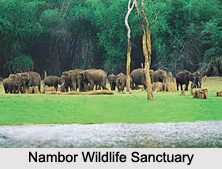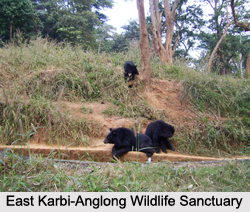 The state of Assam is located in the north eastern part of India. Tea and silk produced in this state have made it popular in India. The natural beauty of Assam, along with temples, museums, rock cut caves, etc attract a number of tourists to this state. Assam also has wildlife sanctuaries, which are protected areas maintained to provide shelter to the flora and flora in the state.
The state of Assam is located in the north eastern part of India. Tea and silk produced in this state have made it popular in India. The natural beauty of Assam, along with temples, museums, rock cut caves, etc attract a number of tourists to this state. Assam also has wildlife sanctuaries, which are protected areas maintained to provide shelter to the flora and flora in the state.
Bornadi Wildlife Sanctuary
Bornadi Wildlife Sanctuary is situated at the foothills of Himalayas in Udalguri district and Baksa district of Assam, bordering Bhutan in the north. It was established in the year 1980 and occupies an area of about 26.22 square kilometers. The aim behind its establishment was the protection of hispid hare and pigmy hog. The occupants of this sanctuary are golden langur, clouded leopard, hoolock gibbon, migratory and local birds like peafowl, hornbill, etc.
Nambor Wildlife Sanctuary
Nambor Wildlife Sanctuary is located in Karbi Anglong district. It was given the status of a sanctuary on 27th of July, 2000. This sanctuary occupies an area of about 37square kilometers. Bhelu, Gomari, Ajar, Nahor, Udiyam, Poma, orchids, elephant, hoolock, birds, reptiles, etc comprise the biodiversity of Nambor Wildlife Sanctuary.
Pobitora Wildlife Sanctuary
Pobitora Wildlife Sanctuary is situated in Morigaon district. It occupies an area of about 38.80 square kilometers. This sanctuary is noted for the great Indian one-horned rhinoceros. Apart from rhinoceros, Pobitora houses leopards, wild boars, barking deer, wild buffalo, more than 2000 migratory birds and reptiles.
Chakrashila Wildlife Sanctuary
Chakrashila Wildlife Sanctuary falls under Dhubri and Kokrajhar districts. It occupies an area of about 45.568 square kilometers. This sanctuary serves as a home to mammals, birds, species of reptiles and butterflies. This sanctuary is noted for golden langur and is the second protected habitat for golden langur in India.
Laokhowa Wildlife Sanctuary
Laokhowa Wildlife Sanctuary is located on the south bank of the Brahmaputra River in Nagaon district. This sanctuary is spread over an area of about 70.13 square kilometers and is a part of the Laokhowa-Burachapori eco-system. Some of the species protected in the sanctuary are Indian rhinoceros, Asiatic water buffaloes, royal Bengal tiger, Indian leopard, etc.
Bherjan-Borajan-Padumoni Wildlife Sanctuary
Bherjan-Borajan-Padumoni Wildlife Sanctuary is located in Tinsukia district. It is spread over an area of about 7.22 square kilometers. Some of the species protected in the sanctuary are hoolock gibbon, capped langur, pig-tailed macaque, etc.
Other Wildlife Sanctuaries of Assam
Garampani Wildlife Sanctuary, East Karbi-Anglong Wildlife Sanctuary and Burachapori Wildlife Sanctuary are some of the other Wildlife Sanctuaries of Assam.











